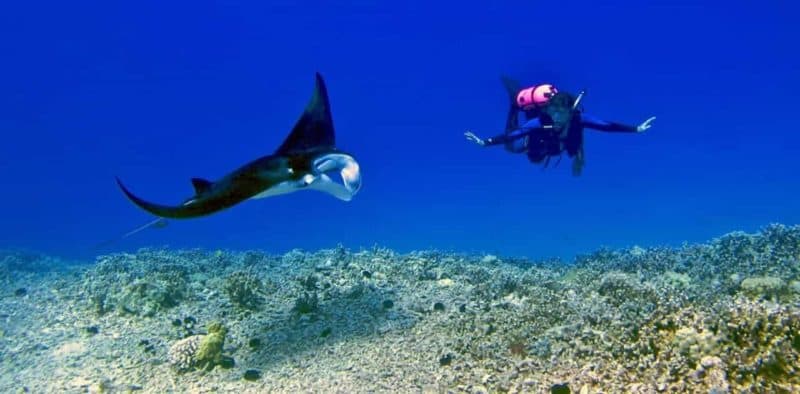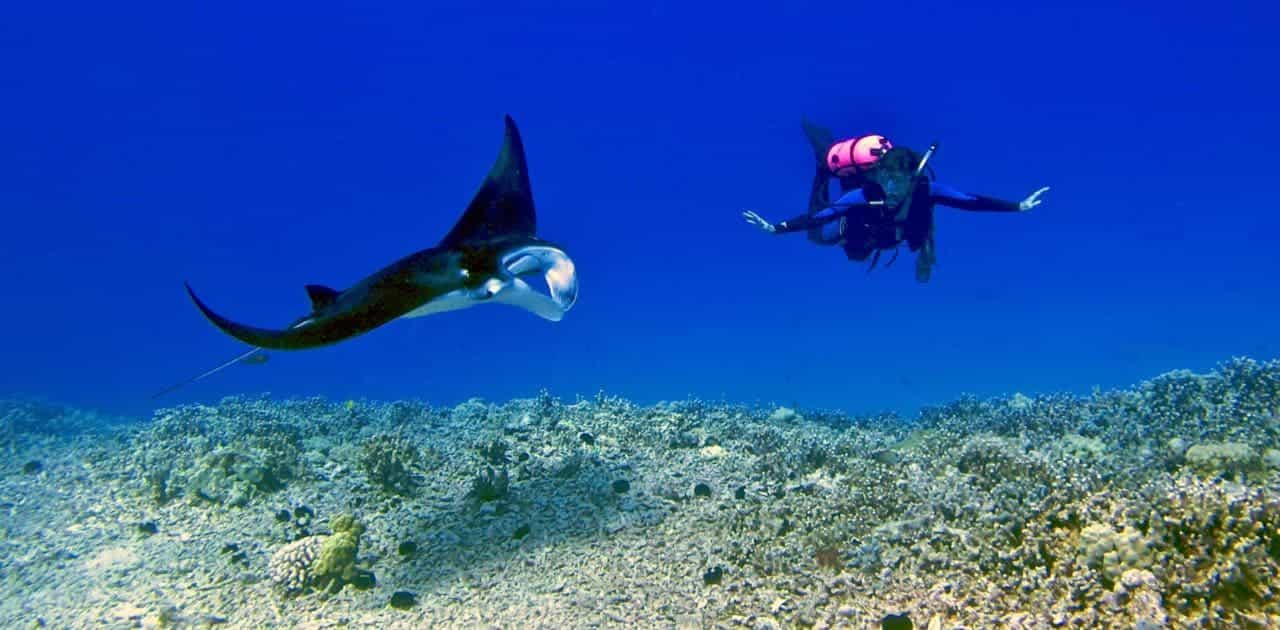The underwater world around all Hawaiian Islands is a #1 destination for Scuba divers world wide. Diving on the Big Island is a great way to get away from the crowds and to explore the underwater landscapes on your own. The abundance of sea life in each color of the rainbow is amazing and you can spend your whole vacation exploring the many sea caves, submerged lava tubes, and coral belts that surround the island.
We discuss the following topics in our dive guide for the Big Island:
Table of contents
- Shore Diving spots and diving conditions
- Diving Tours + Gear Rental
- The Manta Ray Night Dive
- Getting certification
- Scuba diving safety tips
- Should you go Diving or Snorkeling?
Table of Contents
- Shore Diving spots and diving conditions
- Diving Tours + Gear Rental
- The Manta Ray Night Dive
- Getting certification
- Scuba diving safety tips
- Should you go Diving or Snorkeling?
To get you excited about the Big Island diving scene we include the following video shows a compilation by Chris Biela of highlights shot during a 7-day diving trip to the Big Island:
Dive spots and diving conditions
Most visitors to the Big Island choose to go on a diving tour. Local dive operators know how to pick the best spots and how to get you there (read more about these dive tours in the next section). There are also plenty of possibilities to go shore diving though.
Shore diving locations:
If you want to go out and explore the Big Island scuba locations yourself we recommend that you look at the west (Kona) side of the island. Some outstanding locations are Puako, Kealakekua bay, Puʻuhonau o Honaunau (place of refuge) and “mile marker 4” (just south of Kona).
If you are looking for an easy entry into the water, check out shore diving at e.g. Kawaihae, Hoʻokena Beach Park, Kua Bay, the Kailua Pier, and, again, 2 Step and Puako.
For more info and dive reports on these and more diving spots, see the Zentacle overview of dive spots on the Big Island.
Diving conditions: “location, location, conditions”
“Location, location, location” is a phrase often heard from realtors, but it is definitely also appropriate for diving spots. However, for a truly memorable dive we need to change this phrase with one word into: “location, location, conditions”.
Even if you would be diving in Neptune’s treasure trove itself, you would not be able to enjoy doing so if you couldn’t see anything.
Diving locations around the Big Island can be split roughly in two: Those on the Kona side and those on the Hilo side. In general, diving conditions are better at the Kona side with less murky waters and more sunshine. Water visibility over 100 ft. is common here. Dive conditions depend of course on local weather conditions.
You encounter the best diving conditions for diving from spring through fall when the surf is lower and thus has less impact on visibility conditions. During wintertime surf can get high which will murky the waters.
Diving Tours and Gear Rental
Dive shops around the island offer rentals for offshore scuba diving around the Big Island. Most also offer dive tours and provide food, transport and equipment. Note that you need the proper certification to rent diving gear.
Diving tours departing from the Kohala Coast
The Kohala coast is the oldest part of the island which means the underwater world has had most time to develop. Here, you can find many underwater tunnels, lava tubes, arches, ledges, and of course reefs. This also is the driest part of the Big Island which means the water here is very clear.
Kohala Divers (highly recommended, see below) is a small family owned company that employs a team dedicated to safety and service. Their guides are friendly and professional, and their company offers some of the highest rated dive experiences in the state!
6-hour Morning Dive at 2 Stunning Kohala Coast Dive Sites
Dive at 2 Kohala Dive Sites with great underwater scenes on offer for every diver’s experience level (and snorkelers as well)
from:
$209
What is a suggested tour?Our suggested tours are hand-picked tours that receive consistent good reviews, give back to the community, and work hard to minimize their impact on the environment. Read more about these tours on our website.Diving Tours departing from Kailua Kona
The Kona Dive Company and Torpedo Tours (see below) are two great options to go diving, rent gear, or take courses, in Kailua Kona.
2-Tank Morning Dive on the Kona Coast
Explore world renowned Hawaiian reefs, lava tubes, and more! Not certified? No problem! Go for an introductory dive under the direct supervision of one of our world class instructors!
from:
$180
What is a suggested tour?Our suggested tours are hand-picked tours that receive consistent good reviews, give back to the community, and work hard to minimize their impact on the environment. Read more about these tours on our website.Diving Tours departing from Hilo
If you want to go scuba diving on the east side of the Big Island (Hilo, Puna) have a look at the Nautilus Dive Center in Hilo.
The manta ray night dive
Next to seeing the lava the manta ray dive is one of the most memorable things you can do on the Big Island. Imagine floating in the dark ocean holding only a flashlight, and being surrounded by the playing benign giants swirling around you!
There are several companies on the Kona coast offer this option (see below) but we prefer recommending the manta ray dive organized by Torpedo Tours because of their commitment to manta ray safety through their active membership of the Manta Ray Green List.
Manta Ray Night Snorkel & Dive
The famous manta ray night dive/snorkel in Kona is one of the most memorable dives around the planet. 100% Hawaiian Bucket List!
from:
$129
What is a suggested tour?Our suggested tours are hand-picked tours that receive consistent good reviews, give back to the community, and work hard to minimize their impact on the environment. Read more about these tours on our website.This one paragraph barely does justice to this experience which is why we have dedicated and entire guide to this activity. Read more about the Manta Ray Night Dive on our website.

A female scuba diver swims with a young male Manta ray in the Kona district / Big Island. By Steve Dunleavy from Lake Tahoe, NV, United States – Nick and Isabelle, Kona Hawaii, CC BY 2.0, Link
What certification do you need for Scuba or Snuba diving?
To rent scuba gear and go scuba diving you need to be either PADI or NAUI certified.
If you are not yet certified but want to go scuba diving anyway, you have two choices: Either get certification during a course on the island (such as the one offered by Liquid Cosmos Divers), or go ‘snuba’ diving:
- For beginners there are so-called “Resort Courses” that qualify you for an introductory scuba dive in mere hours. During the resort course you get diving instructions for a couple of hours in a swimming pool and afterwards you are certified to go on a guided dive. There is of course also the opportunity to take a full certification course. What better place to learn how to dive than in Hawaii?
- If you don’t care for a resort course but still want to go deep under water, consider SNUBA diving. Snuba divers breathe underwater by means of a 20 foot air line which is connected to a standard scuba tank. The tank is mounted on a raft on the surface that follows your every movement. Every Snuba tour is guided by a diving professional.
Scuba diving safety tips
- Have the proper qualifications: To rent diving gear, you should be either PADI or NAUI certified. If you have not dived for a while or are inexperienced, dive with an instructor and consider a “Resort Course”.
- Be prepared: Always rent high quality equipment. You don’t want your gear to fail 20 feet below the surface! Also, plan ahead. Check the local weather conditions, wear shoes, gloves and a wet-suit to protect you from the cold and sharp coral and lava rocks. Do not fly or travel to high altitudes (e.g. Mauna Kea or Mauna Loa) within 24 hours after your dive
- Be careful: Always check your entry and exit points before diving. Never dive alone or use up all the air in your tank. Completely check out the dive location before choosing whether to make the dive.
- Have fun! Take in the spectacular underwater world around Hawaii. Consider taking along an underwater camera for some spectacular shots.
Should you go diving, snorkeling, or both?
Snorkeling and scuba diving are great fun and neither is “better” than the other. Actually, both are on our (admittedly long) list of things we love to do while on the Big Island!
Diving and snorkeling are two different way to explore the ocean and each option has their own (dis)advantages. If you already are certified to dive you probably will go diving anyhow but for those people still on the fence the following list may help to make a choice about getting certified (or to take a SNUBA diving tour) while visiting Hawaii:
Scuba diving (dis)advantages:
- Scuba diving is more expensive than snorkeling because you need more gear. You also need to properly plan each dive.
- Diving gives you an amazing 3-dimensional freedom to explore the underwater world. You get to see the fish and coral from really close and you get to see habitats that are impossible to see/reach while snorkeling
- Scuba diving requires effort and good health. You have to maintain equipment, fitness and certifications.
- Scuba diving is not without risk. Have a look at our 4 scuba diving safety tips for details.
- Renting scuba diving equipment is more expensive than renting snorkeling gear.
Snorkeling (dis)advantages:
- Snorkeling is for (almost) everyone! All you need is the ability to swim, to breathe, and to have fun :D
- Snorkeling is more “low effort” and doesn’t require advanced planning. You can bring a snorkel and goggles with you to the beach and use them whenever you want.
- Snorkeling is very affordable. Buying snorkeling gear costs a few tens of dollars and rentals can cost as little as $20/day.
See our snorkeling guide for more information about snorkeling (locations, gear rental and tours) on the Big Island.
